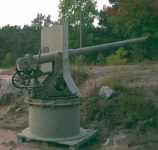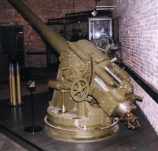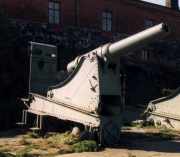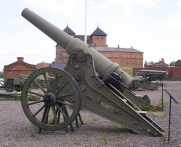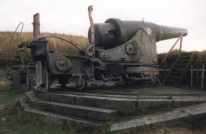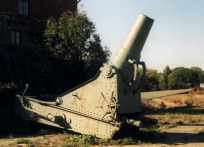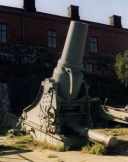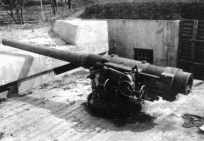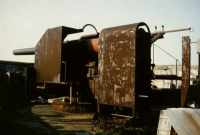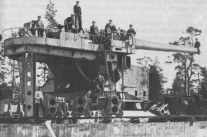Weaponry of infantry
A Russian infantry solder had a 7.62 mm rifle, model 1891 as a personal weaponry. Officers and under officers had also the Nagant revolver, model 1895.
Machine guns belong to heavier weaponry. First Maxim machine guns, model 1905, were ordered from Germany. They were modified to use Russian 7.62 rifle bullets. First models were equipped with a high carriage, big wheels and large armored shield. The Maxim machine gun, model 1910, were the most common gun in the land front of Krepost Sveaborg. This newer model has carriage with smaller wheels, but had also feet so the gun could be lifted to the higher position.
Beside the Maxim machine guns there were also Colt-Browning and Vickers machine guns in the Russian fortress army. First light infantry mortars were made in Finnish metal industry factories. Infantry used also many types of small caliber cannons. Muzzle loading bronze mortars to anti-aircraft guns were found from land front storage areas after the war.
Artillery
Here are the most common guns which were used in the land front of Krepost Sveaborg. Note that some of the characters, for example range, could varied with different shells and charges. Some of the guns were modified after the first world war when the characters were changed.
6 pounder QF Nordenfelt Coast Defense Gun
57/48 No Caliber 57 mm Length of the barrel 47.8 cal. Range 5.6 km Rate of the fire 20 rounds/min Weight of the shell 4.9 kg Photo: Ove Enqvist (1999)
75 mm 50 caliber gun, model Canet
75/50 C Caliber 75 mm Length of the barrel 50 cal. Range 9 km Rate of the fire 15 rounds/min Weight of the shell 1.5 kg
152 mm (6") heavy fortress and siege cannon, model 1877, barrel weight 120 puds
152 K 77-120 p Caliber 152.4 mm Length of the barrel 21.3 cal. Range 7.1 km Rate of the fire 1.5 rounds/min Weight of the shell 35 kg
